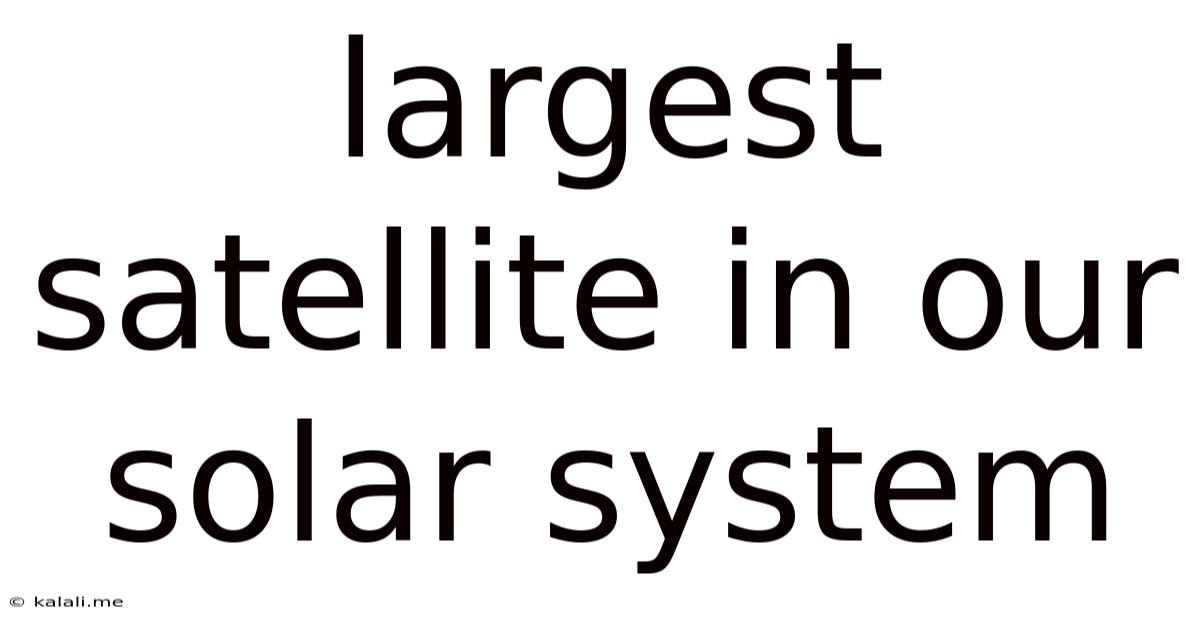Largest Satellite In Our Solar System
Kalali
Jun 11, 2025 · 3 min read

Table of Contents
Ganymede: The Largest Satellite in Our Solar System
Ganymede, a celestial giant orbiting Jupiter, holds the title of the largest moon in our solar system. This fascinating icy world surpasses even the planet Mercury in size, boasting a diameter of 5,268 kilometers (3,273 miles). Its sheer size and complex features make it a prime target for scientific exploration, revealing clues about the formation of our solar system and the potential for life beyond Earth. This article delves into the captivating features and mysteries surrounding this colossal moon.
A World of Extremes: Ganymede's Unique Characteristics
Ganymede isn't just big; it's unique. Its surface is a striking tapestry of ancient, heavily cratered terrain juxtaposed with younger, grooved regions suggesting tectonic activity. This dichotomy hints at a dynamic geological history, far more complex than initially imagined. The presence of these grooves indicates internal processes, possibly involving subsurface oceans and tectonic plates – a surprising finding for a moon.
- Magnetic Field: Remarkably, Ganymede is the only moon known to possess its own intrinsic magnetic field, a powerful shield protecting it from the harsh radiation environment of Jupiter. This magnetic field is thought to be generated by a salty ocean deep beneath its icy crust, further fueling speculation about the possibility of life.
- Surface Composition: The surface is primarily composed of water ice, with various impurities and possibly silicate rock. Observations show a fascinating variety of landforms including vast plains, extensive crater chains, and mountainous regions.
- Ocean World: Strong evidence suggests the presence of a vast subsurface ocean, possibly containing more water than all the Earth's oceans combined. This ocean is believed to be sandwiched between layers of ice, with the potential for hydrothermal vents on the ocean floor – a key ingredient for the emergence of life.
- Thin Atmosphere: Ganymede possesses a very thin oxygen atmosphere, far too tenuous to support life as we know it. However, its existence further adds to the complexity and intrigue of this remarkable celestial body.
Exploring Ganymede: Past, Present, and Future Missions
Several spacecraft have provided invaluable data about Ganymede. Pioneer 10 and 11, Voyager 1 and 2, and the Galileo spacecraft all contributed to our understanding of this moon. The Galileo mission, in particular, provided high-resolution images and crucial data about Ganymede's magnetic field and potential subsurface ocean.
Future missions, such as the European Space Agency's JUICE (Jupiter Icy Moons Explorer) mission, are planned to conduct in-depth studies of Ganymede. JUICE aims to further investigate Ganymede’s subsurface ocean, its magnetic field, and its surface composition, potentially answering long-standing questions about the potential for life beyond Earth and furthering our comprehension of Jovian moon formation.
The Significance of Ganymede in Planetary Science
The study of Ganymede is crucial for understanding the formation and evolution of planetary systems. Its size, composition, and unique features offer valuable insights into the processes that shaped our solar system and the potential for life to exist in environments vastly different from Earth. Further exploration of this icy giant promises to unravel even more of its secrets, pushing the boundaries of our knowledge about the universe and our place within it. The continued exploration of Ganymede will undoubtedly provide groundbreaking discoveries and shape our understanding of planetary science for years to come.
Latest Posts
Latest Posts
-
How Fast Is 200 Km Per Hour
Jul 01, 2025
-
How Many Babies Were Conceived At Woodstock 1969
Jul 01, 2025
-
How Many Feet Is In 40 Yards
Jul 01, 2025
-
Least Common Denominator Of 9 And 7
Jul 01, 2025
-
How Many Feet In A Mile And A Half
Jul 01, 2025
Related Post
Thank you for visiting our website which covers about Largest Satellite In Our Solar System . We hope the information provided has been useful to you. Feel free to contact us if you have any questions or need further assistance. See you next time and don't miss to bookmark.